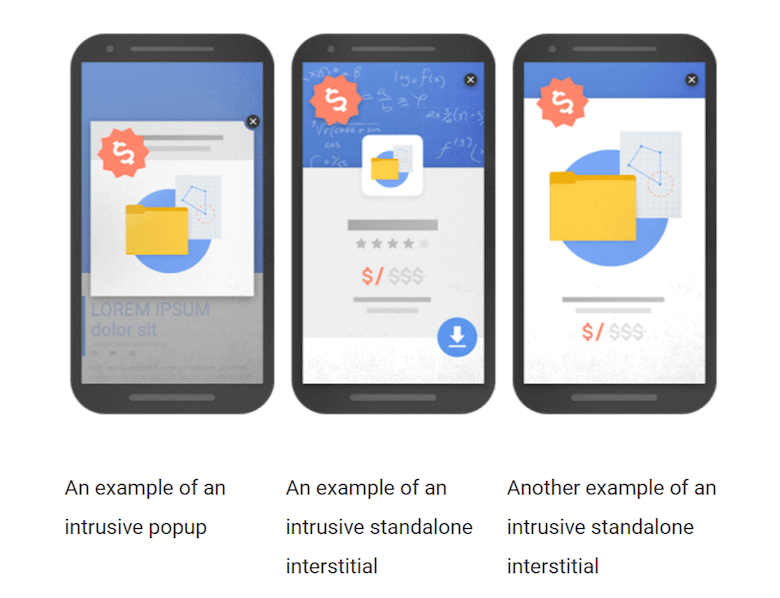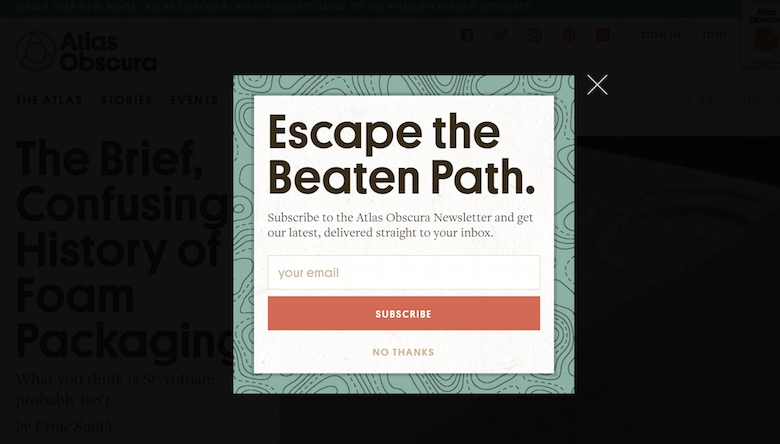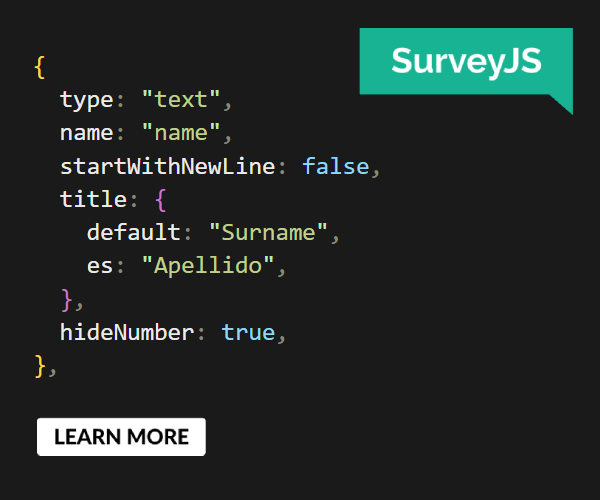Intrusive Interstitials: Guidelines To Avoiding Google’s Penalty
In 2015, Google announced that mobile searches surpassed desktop searches in at least 10 countries. 56% of traffic on major websites comes from mobile. In light of this, Google’s decision to improve the mobile user experience by various means, such as AMP pages and a dedicated mobile index, comes across as a sound business move.
More than half of the 2 trillion searches Google processes each year come from mobile devices. Mobile devices have changed the way we approach search, ushering in new types of habits such as local search, voice search and more. These consumer habits have greatly affected the way search engine providers think about user search intent.
A new type of mobile improvement was rolled out by Google. The search giant has decided to launch a war against interstitials that ruin the user experience. As a result, any website found guilty of showing intrusive popups, banners or overlays (called interstitials) will see its content demoted in Google’s mobile search results. We’ll be looking at what’s being penalized, what’s allowed and some workarounds to help you cope with this new penalty.
Mobile Reality
Two years ago, Google introduced a mobile-friendly label as it began prioritizing mobile websites. The aim was to push websites that offer a substandard user experience to improve their design, code and content. These guidelines are updated quite often as Google aims to keep the mobile user experience center stage:
- AMP
- “Guidelines for Mobile Web Development,” Smashing Magazine
- “Responsive Web Design Basics,” Pete LePage, Web Fundamentals, Google Developers
- “Enabling Deep Links for App Content,” Android Developers
- “Google Algorithm Change History,” Moz
With a dramatically levelled playing field, various elements are fighting to be displayed on one small screen. Coupons, offers, newsletter registration, ads, text, photos, social sharing buttons, and live chat are all vying for some valuable mobile screen space. Often, the visitor pays the price as their mobile experience becomes a confusing mess. Google’s latest penalty aims to change how we think about mobile advertising.
Introducing The Intrusive Interstitial Penalty
One recent change made this year is the intrusive interstitial update. This algorithm update has one mission: to penalize for intrusive popup ads that affect the mobile user experience. The update rolled out earlier this year. Certain websites saw their mobile rankings in Google lowered.
Decrypting The Intrusive Interstitial Update
First and foremost, it’s a mobile popup penalty. Secondly, it’s an intrusive popup penalty. Google wants to make sure that ads and popups do not interfere with the user experience on a mobile screen. The intent behind devaluing pages with popups and overlays that take up most of the screen is to help users access the content they’ve requested in the first place.
What Is The Impact Of This Latest Update?
Google will no longer consider pages with intrusive interstitials as being mobile-friendly. Bottom line: Obstructing content on mobile with ads or other popups is against Google’s guidelines. The main target of this update is overlays that gray out the content, making the content inaccessible for a few seconds or until the user miraculously manages to tap the minuscule “X” with their sausage fingers to dismiss the ads. Ads displayed over content are no longer acceptable on mobile. This includes popups that appear when you load the page from Google or when you scroll down. For many websites, playing according to Google’s rules means removing all barriers that could prevent the user from reading the content on the page at any time.
What Is An Interstitial?
Interstitial spaces can be defined as a type of “web page” that appears before or after the page (in a website or an app) expected by the user. Essentially, it is something that blocks out the website or app’s main content. These spaces have served as a promotional tool for many online marketers. They can contain advertisements, surveys, newsletter signup forms, coupons and other various calls to action.
What Constitutes An Intrusive Interstitial?
Intrusive interstitials tend to block most or all of a page, leading to a frustrating experience for desktop and mobile users alike. These ads hinder the experience because they are unexpected and block the content that users seek. On the desktop, they’re annoying at best, but on mobile, intrusive interstitials can ruin the entire experience. Ever had to deal with popups gone rogue on mobile? Google has been relatively straightforward in its definition of what constitutes an intrusive interstitial. A few types of interstitials are problematic, as defined by the new guidelines:

- a popup or modal window that blocks most or all of the content on a page (this is basically a full-screen interstitial above the header);
- a standalone interstitial that’s not responsive and that blocks the content;
- a layout in which the content above the fold has the look and feel of an interstitial and requires dismissal or scrolling in order for the user to reach the main content beneath the fold.
If your popups cover the main content shown on the screen, pop up without user interaction or require a dismissal before disappearing, chances are that they will trigger an algorithmic penalty.
Popups that incite users to choose their country or their preferred language are also targets because they fit the description above of what constitutes an intrusive interstitial. They bother readers and are not a necessity.
What’s Not Intrusive?
Not all interstitials are targeted by this penalty. Some exceptions exist, such as interstitials that are in place for legal or ethical reasons. The following popups do not require a change of size, design or position within a page:

- age-verification blockers that act as a shield for certain content, such as alcohol-related or adult content;
- cookies that use popups that serve as consent notifications as required by the EU;
- any other type of legally required popup.
Gray Area
The official guidelines provided by Google are pretty vague at times. The company’s definition of what constitutes an intrusive interstitial is not clearcut. Many elements are not addressed, such as:
- sticky sidebars,
- related posts,
- share buttons,
- live chat boxes,
- coupon popups.
The jury is still out on whether these elements will be targeted by the algorithm update, even if they comply with the guidelines on interstitials. Navigating this gray area can be tricky. If you want to come out on top, we recommend designing these elements in a way that ensures they do not cover any of the page’s actual content. Making sure these notifications do not hinder the user experience can go a long way towards avoiding a penalty.
What Is Still Permitted (But Intrusive Nonetheless)
Make no mistake, as of 10 January 2017, interstitials are a new ranking signal for mobile SEO. It doesn’t necessarily mean that all types of popups should be banned.
Intrusive Popups Are Still OK On Desktop
This penalty targets mobile issues. Overlays, popups and other types of interstitials will live another day on desktop.

Interstitials Triggered By Exit Intent Are Still Allowed
Here is Google’s John Mueller’s advice on interstitials triggered by exit intent:
"At the moment, those wouldn’t count. What we’re looking for is, really, interstitials that show up on the interaction between the search click and going through the page and seeing the content. So, that’s kind of the place we’re looking for those interstitials. What you do afterwards, like if someone clicks on stuff within your website or closes the tab or something like that, then that’s kind of between you and the user."
Page-to-Page Interstitials Will Not Be Penalized
Google is not looking to penalize all pages with interstitials, only the ones that searchers could land on from search results. It’s still OK to display an interstitial when a user navigates from one of your pages to another. If a user can find a page by searching for something on Google, then you’ll need to ensure that this page has no intrusive interstitials. If after landing on this page, the user decides to navigate to another page on the website that is not listed by Google, then interstitials would be allowed on that page. Sounds a bit convoluted, but this has been confirmed by Google.
Will You Be Penalized?
Google’s main objective is to make the web more accessible, intuitive and usable, especially for mobile users. If your popups serve a real purpose that add value for the user, chances are you should be OK.
How The Penalty Works?
This mobile interstitial penalty is rolling out on a recrawling basis. Basically, the next time Google’s bot crawls your website after 10 January 2017, it will evaluate the interstitials present on mobile. The penalty could hurt, but so far the reported impact has been minimal.
How To Identify Intrusive Interstitials
Auditing your popups is a great way to determine whether your mobile website is compliant. Start by reviewing the mobile popups, because desktop popups are not going to be penalized. Prefer small messages such as banners, inlines and slide-ins for mobile pages.

Testing Tool
Google has stated that it will not release an official tool to test websites. However, there is a tool out there, Interstitial Penalty Check, that uses image recognition to identify potential interstitials on your pages. It measures how much space popups take on the screen to flag the ones at risk.
Audit Your Popups
- Identify required interstitials, such as age-verification popups and cookie notifications.
- Identify all other popups, and evaluate them according to the amount of space they take up.
- Make note of any third-party scripts present on your website that might trigger popups. You will often find these if you use a CMS.
- For WordPress users, check your plugins. Some plugins used to display popup messages for coupons, membership offers, promotions and other types of ads need to be reviewed. You might have to adjust the sizes using the plugins’ settings.
Interstitial Design Guidelines
Any banners that take up a “reasonable amount of space” will not be targeted. That’s great news! However, no exact guidelines have been communicated by Google. The recommended size is 15% or less, even in landscape mode, because it still allows readers to access several lines of text.
Keep In Mind What Google Is Looking For In A Positive User Experience
Popups aren’t being banned, but marketing efforts will have to adapt to these new restrictions. Let’s rephrase that: Marketing efforts will have to respect the user’s screen space. Try to redesign any interstitials that were previously considered essential to marketing efforts. You can replace them with a link to a separate page or an inline ad, for example.
For instance, language-selection interstitials can be phased out, in favor of a banner on the website. But first evaluate whether such an element is worth that much screen space: Users arrive with a linguistic context already if they’ve come from Google.
Workarounds
If your website suffers a significant drop-off in conversion following the removal of some interstitials, then you’ll have to work around the issue. Luckily for you, only pages listed in Google’s search results are being targeted. If a user navigates to another page on your website, then a popup placed there would not be a problem for Google. The entry page is the issue for the search engine. This isn’t particularly recommended, but if interstitials remain the best way to convert users for your website, then consider keeping them on the website (and away from Google by placing a no-index tag in your code). Keep in mind that this would mean cutting off organic traffic from Google to that page.
News From The War On Interstitials
False Positives Penalties
Some websites have been hit by Google’s mobile interstitial penalty even though they were adhering to the guidelines. Other websites that should have been affected have not encountered any negative impact yet. So, what do you do if you’ve been hit unfairly? Head on over to the Google Webmaster Help forum to give feedback to the Google team.
How To Recover From A Penalty?
If your traffic has suffered because of this penalty, we recommend auditing your popups and removing the ones deemed intrusive. Once that’s done, you’ll have to wait until Google recrawls your pages. You can also submit your pages via the Google Search Console’s fetch and submit tool to kickstart the recrawling effort a bit. This should remove the demotion in mobile ranking inflicted on your website.
Google’s John Mueller confirms that the demotion would be removed in real time when the pages are recrawled and reindexed. This penalty is doled out in real time, meaning that recovery will depend on how frequently Google indexes those pages. For most websites, though, “real time” means waiting until each individual page is crawled by Google and the demotion is removed.
Adapt Or Die: Looking Into New Strategies
Yes, popups are frustrating, but companies use them because they are effective. SumoMe shares recent findings that establish the interstitial’s track record: An average conversion rate is 3.09%, versus 9.28% on average for high-performing popups.
Removing revenue-generating interstitials could hurt websites at first, but losing organic search traffic could hurt their revenues even more. Designers, developers and marketers must work together to find new, non-intrusive ways to generate revenue. A sound strategy would be to leverage content marketing to educate audiences and guide them through the buying process.
This means moving away from interruption marketing towards permission marketing. The first can be defined as an annoying version of the traditional way of doing marketing via advertising, promotion and sales, whereas the latter is about promoting and selling a product to a potential client who explicitly agrees to receive marketing information. Google is aware that many websites are supported by ads.
Its AdSense is based in part on this revenue model. There are pros and cons to this new update. It could mean more time on website, more page views and a lower bounce rate, but it could still harm revenue in the short to medium term. Google representatives have stated publicly that they don’t want confusing ads — so, if there’s any question about what is an ad and what is the main content, you could have a problem. Therefore, label your ads as sponsored content, make them unobtrusive, and you should be fine.
In the meantime, audit your popups, cookie notifications, overlays and big banners to make sure they comply with Google’s new guidelines. Make sure they don’t take up more than 15% of the screen to avoid a penalty. If you do get penalized, don’t panic; fix the issues, and wait for Google’s bot to visit your website again. The bot should notice your efforts and remove the penalty.
Further Reading
- Is Your Responsive Design Working? Google Analytics Will Tell You
- Everything You Need To Know About Google’s Accelerated Mobile Pages
- World Wide Web, Not Wealthy Western Web
- Google’s Mobilegeddon Aftermath: Eight Months Into A Better Mobile Web



 SurveyJS: White-Label Survey Solution for Your JS App
SurveyJS: White-Label Survey Solution for Your JS App


 Agent Ready is the new Headless
Agent Ready is the new Headless

